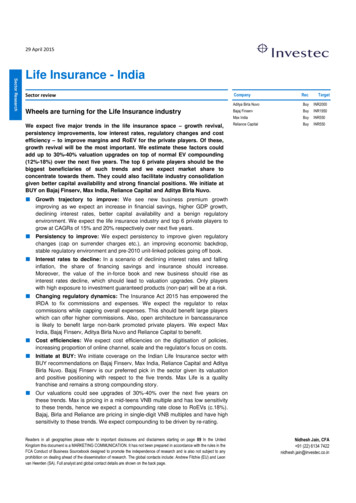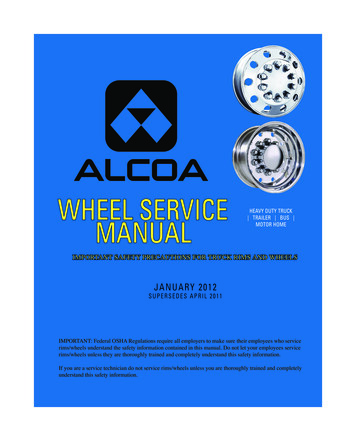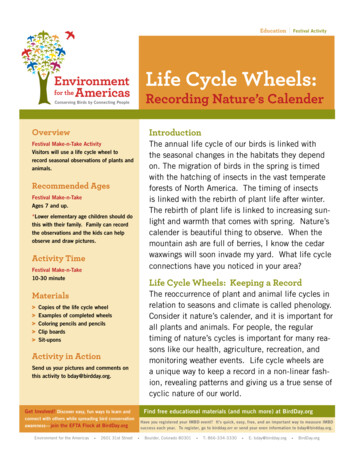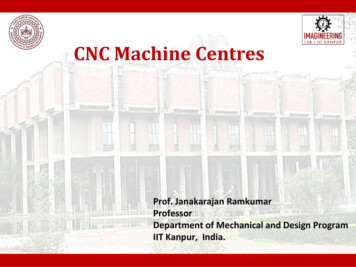
Transcription
29 April 2015 AggregName2 Sector ResearchLife Insurance - IndiaSector reviewCompanyRecTargetAditya Birla NuvoBuyINR2000Wheels are turning for the Life Insurance industryBajaj FinservBuyINR1950Max IndiaBuyINR550We expect five major trends in the life insurance space – growth revival,persistency improvements, low interest rates, regulatory changes and costefficiency – to improve margins and RoEV for the private players. Of these,growth revival will be the most important. We estimate these factors couldadd up to 30%-40% valuation upgrades on top of normal EV compounding(12%-18%) over the next five years. The top 6 private players should be thebiggest beneficiaries of such trends and we expect market share toconcentrate towards them. They could also facilitate industry consolidationgiven better capital availability and strong financial positions. We initiate atBUY on Bajaj Finserv, Max India, Reliance Capital and Aditya Birla Nuvo.Reliance CapitalBuyINR550Life Ins urance: Growth trajectory to improve: We see new business premium growthimproving as we expect an increase in financial savings, higher GDP growth,declining interest rates, better capital availability and a benign regulatoryenvironment. We expect the life insurance industry and top 6 private players togrow at CAGRs of 15% and 20% respectively over next five years. Persistency to improve: We expect persistency to improve given regulatorychanges (cap on surrender charges etc.), an improving economic backdrop,stable regulatory environment and pre-2010 unit-linked policies going off book. Interest rates to decline: In a scenario of declining interest rates and fallinginflation, the share of financing savings and insurance should increase.Moreover, the value of the in-force book and new business should rise asinterest rates decline, which should lead to valuation upgrades. Only playerswith high exposure to investment guaranteed products (non-par) will be at a risk. Changing regulatory dynamics: The Insurance Act 2015 has empowered theIRDA to fix commissions and expenses. We expect the regulator to relaxcommissions while capping overall expenses. This should benefit large playerswhich can offer higher commissions. Also, open architecture in bancassuranceis likely to benefit large non-bank promoted private players. We expect MaxIndia, Bajaj Finserv, Aditya Birla Nuvo and Reliance Capital to benefit. Cost efficiencies: We expect cost efficiencies on the digitisation of policies,increasing proportion of online channel, scale and the regulator’s focus on costs. Initiate at BUY: We initiate coverage on the Indian Life Insurance sector withBUY recommendations on Bajaj Finserv, Max India, Reliance Capital and AdityaBirla Nuvo. Bajaj Finserv is our preferred pick in the sector given its valuationand positive positioning with respect to the five trends. Max Life is a qualityfranchise and remains a strong compounding story. Our valuations could see upgrades of 30%-40% over the next five years onthese trends. Max is pricing in a mid-teens VNB multiple and has low sensitivityto these trends, hence we expect a compounding rate close to RoEVs (c.18%).Bajaj, Birla and Reliance are pricing in single-digit VNB multiples and have highsensitivity to these trends. We expect compounding to be driven by re-rating.Readers in all geographies please refer to important disclosures and disclaimers starting on page 89 In the UnitedKingdom this document is a MARKETING COMMUNICATION. It has not been prepared in accordance with the rules in theFCA Conduct of Business Sourcebook designed to promote the independence of research and is also not subject to anyprohibition on dealing ahead of the dissemination of research. The global contacts include: Andrew Fitchie (EU) and Leonvan Heerden (SA). Full analyst and global contact details are shown on the back page.Nidhesh Jain, CFA 91 (22) 6134 7422nidhesh.jain@investec.co.in
ContentsIntroduction . 3Broad expectations in Indian Life Insurance sector . 4Trend 1: Insurance industry is expected to witness growth revival . 4Trend 2: Persistency is expected to improve . 10Trend 3: Interest rate decline . 15Trend 4: Changing regulatory dynamics could favour large players . 16Trend 5: Cost of operations coming down . 18Sensitivity to the five trends . 19India life insurance industry has seen one complete cycle . 21How should one look at the industry? . 24How life insurance companies make money . 24Cost overruns and low persistency have been problems in India . 27Regulations have been an issue in the past . 29How life insurance is distributed in India . 31What products are sold in India? . 32Indian Life Insurance industry vs other geographies . 34India insurers’ vs Global Insurance companies . 35Relative positioning of life insurance companies. 37Our valuation of Indian Life Insurers . 40Company sectionAditya Birla Nuvo (ABRL.NS) . 41Bajaj Finserv (BJFS.NS) . 52Max India (MAXI.NS) . 65Reliance Capital (RLCP.NS) . 76Page 2 29 April 2015
IntroductionWe expect the Indian life insurance industry to benefit from five major trends on theoperating level over the next five years (see table 1). Growth revival, in our view, isthe most important and could lead to 10%-20% upgrades to valuations alone.Table 1: Broad expectations in life insurance sector and their implicationsTrendsInvestec's expectationImplicationsGrowthRevivalWe expect NBP growth to improve to 20% CAGR fortop-6 private players over next five years.Embedded Value accretion and VNB margins will improve.We expect 10%-20% upgrades to our valuations for every 10% upgrades ingrowth estimates.PersistencyimprovementWe expect persistency to improve due to regulatorychanges, better economic environment and players'focus.Low interestratesThere is expectation of decline in interest rates in theeconomy over next 24 months as inflation ciesWe expect final guidelines on open architecture inbancassurance, some relaxations in commission payout and restrictions on overall expenses.We expect cost efficiencies to improve givenincreasing share of variable cost structurebancassurance, emergence of online channel andregulator's focus on lower fixed costs.EV accretion and VNB margins will improve for Par & UL products.We expect up to18% upgrades to our valuations for every 500bps increase inpersistency.EV and VNB margins will get upgraded for Par & UL products. Non-Par productsmay get negatively impacted by declining interest rates.We expect up to 10% upgrades to our valuations for every 100bps decline ininterest rates.Large non-bank promoted players are likely to be big beneficiaries.Players with high proportion of participating products may get impactednegatively.EV accretion and VNB margins will improve. We expect 3%-17% upgrades toour valuations for every 10% decline in fixed costs.Source: Investec Securities estimatesIn addition to these five trends, we expect IPOs of a couple of life insurancecompanies over next 18 months – Max India Financial Services (set to list in FY16)will be first pure play on life insurance sector, while HDFC Life is expected to IPO inFY16/FY17. These should raise the profile of the sector, improve disclosures andincrease understanding of the sector.Table 2: How life insurance companies are placed to leverage these trends?ICICISBIBajajMaxHDFCRelianceBirlaExideTrend 1 - Growth43323332Trend 2 - Persistency32333232Trend 3 - Interest rates42234121Trend 4 - Regulations11322333Trend 5 - Operating costs32422333Overall32323232Source: Investec Securities estimatesBajaj Allianz Life is well placed toleverage the emerging trends in the lifeinsurance sector.Page 3 29 April 2015Bajaj Allianz Life is best placed among the life insurance companies to benefit fromthese five trends, in our view. Max Life has a high proportion of participatingproducts, which have the least sensitivity to operating expenses or persistency.Moreover, the company is operating at high persistency with the lowest proportionof fixed costs so the scope for improvement may be limited (see table 2).
Broad expectations in Indian Life InsurancesectorTrend 1: Insurance industry is expected to witness growthrevivalShare of financial savings as a % of GDP isat a 15-year lowShare of insurance within financialsavings is at an eight-year lowWe expect the growth outlook for the life insurance sector to improve given thefollowing: (a) financial savings (as a % of nominal GDP) are expected to grow; (b)the share of life insurance within financial savings is expected to remain stable orgrow; and (c) nominal GDP is expected to grow at 12%-14% in the next five years.We expect the life insurance sector to grow at a 15% CAGR over the next five yearsassuming a marginal uptick in financial savings rate to 8% of GDP, GDP growth of13% and share of life insurance (within financial savings) remains stable at 17%.Note that the share of financial savings (financial savings as a % of GDP) and shareof life insurance within financial savings have been declining since 2010 (seefigures 1 & 2).Figure 1: Financial savings as % of GDP has come down and 30%Physical savings/GDPFinancial savings/GDP25%20%15%10% 12% 10%11% 11% 12%12%7%7%7%10%5%0%Source: RBI, Investec Securities estimatesFigure 2: Life insurance share within financial savings has declined100%90%80%70%60%50%40% 14% 13% 14%26%30%22%20%17% 17%20%21%21%10%0%Currency &DepositsLife aims on GovtSource: RBI, Investec Securities estimatesTop private players are expected to be gain market shareWe expect the top private players to be the biggest beneficiaries of the revival ingrowth in the industry given that they are:Top private players have gained marketshare among private in the last five years.Page 4 29 April 2015 Well capitalised and able to attract capital: The top players are wellcapitalised, do not require capital and remain most probable IPO candidates.The better capital availability will help them in gaining market share whenbottom players will starve for capital. Scale benefits should accrue for large players: The top players havereached scale and have lower operating expenses compared to other players,which should help them to improve returns to policyholders and shareholders. Regulatory focus on lower fixed costs may benefit large players: TheIRDA may tweak commission rates on the higher side while capping totalmanagement expenses (see page 16 for more details). Given large players willenjoy scale benefits, they are likely to benefit from these changes. Top players set to initiate consolidation in the industry: Mid-size (7 toth18 ) players have lost market share, are not profitable, have weak distributionand require capital. Also, these players may not be able to attract capital. Onthe other hand, the top players are generating cash and should be able toattract capital which can be used for consolidation.thPrivate players have shown market share gains recently (figure 3) while the top 6have been gaining market share for the past five years (figure 4). The players in thethth7 -12 range have been the biggest losers (figure 4).
Figure 3: Private players have gained some market share recentlyPrivateIndividual APE market shareLIC100%Individual APE market shareFigure 4: Top 6 players have gained market %50%40%30%20%10%0%H12015Others13th-18th player7th-12th playerTop-620112012Source: IRDA, Investec Securities estimates20132014 H12015Source: IRDA, Investec Securities estimatesLife Insurance Corporation of India may lose market share from hereonLIC gains market share in time ofuncertainty while private players do wellin times of prosperity.Life Insurance Corporation of India (LIC) lost market share until 2011 when theprivate industry was riding the unit-linked wave, however, it has gained marketshare post 2011 (figure 5). This was driven by (a) regulatory changes in unit-linkedpolicies; and (b) risk aversion among the policyholders on weak macro. We observethat LIC gains market share in times of uncertainty while private players do well intimes of prosperity.Given expectations of economic revival, improving consumer sentiment and theprivate sector stabilising post regulatory changes, we expect LIC to lose marketshare from hereon. Moreover, the emergence of an online sales channel maybenefit private players given their focus on this.Figure 5: LIC New business market sisFigure 6: Proportion of sales coming from direct channelULIPguidelines14%12%10%8%6%4%2%0%LICSource: IRDA, Investec Securities estimatesSBIBirlaBajajICICIMaxHDFC RelianceSource: Company Disclosures, Investec Securities estimatesGiven our expectation of 15% premium growth for the Life Insurance sector, the topprivate players may grow at 20% over the next five years assuming LIC and otherthan the top 6 players cede 1% market share each year.Growth could positively impact life insurers in multiple waysGrowth revival could change the fortunesof the private players. It will lead toupgrades in margin, embedded value andvaluation.Growth will have multiple positive impacts on the fortunes of Life Insurancecompanies as it should lead to positive operating leverage, reductions in costoverruns, improvement in NBAP margins, higher EV accretion and a positive impacton valuations. It should also raise the sector’s profile in the eyes of investors.Operating leverage: More than 55% of operating costs for private Indian LifeInsurance companies are of a fixed nature (figures 7 & 8). Hence, growth in grosspremiums should facilitate significant positive operating leverage for the players.Here, growth in renewal premiums is also very critical, which is a function ofpersistency and new business growth as a higher renewal premium will meanhigher allocation of costs on existing policies versus new policies.Page 5 29 April 2015
Figure 7: Operating costs break-up for Max LifeTrainingServicePolicy issuance Tax, 3% expenses, 3%& servicing cost,6%VariablecostsFigure 8: Fixed costs as % of total costs for Insurers90%Others, 3%80%70%60%Employeesexpenses, 28%Commissionspaid, 40%30%Branchexpenses, 16%20%10%0%Advertisementexpenses, 7%MaxSBISource: Company Data, Investec Securities estimatesPrivate players have high fixed cost whichwill lead to positive operating leverage asgrowth revives.HDFCSource: Company Data, Investec Securities estimatesCost overruns (on embedded value basis) to reduce: Historically, Indian lifeinsurers have suffered due to high cost overruns, which have impacted theirembedded value accretion. This has been due to higher expectations of growth andpersistency than actual levels. There are two kinds of overruns: Acquisition cost overruns: The actual acquisition costs are higher thanestimated when pricing the policy, leading to acquisition cost overruns.Acquisition cost overruns are associated with new business premiums andshould thus be deducted from new business margins (NBM or VNB). Maintenance cost overruns: Costs allocated to renewal business are morethan the estimated costs when pricing the policy. Maintenance cost overrunsare on account of a higher fixed cost base, lower persistency and lower-thanexpected growth in new business.Growth would be critical in eliminating acquisition cost overruns while betterpersistency will lead to lower maintenance cost overruns.Impact of better growth trajectory on margins, embedded value and valuation Margins: Once players break even on embedded value basis, the additionaloperating leverage should lead to margin accretion. Embedded value: A better growth profile in new business premiums shouldlead to higher embedded value growth as (a) cost overruns will be lower; (b)margins may be higher; and (c) the value of new business will be higher due togrowth. Valuation: We value life insurance companies on appraisal value methodology.Appraisal value is defined as the summation of embedded value and structuralvalue. Embedded value is the value of the life insurance company assuming itwill not underwrite any business from here onwards. Structural value is thevalue of the future business that the company will underwrite (figure 9).Figure 9: Valuation of a Life Insurance companyEmbedded valueAdjusted Net WorthStructural ValueValue of future businessValue of in-forceAppraisalvalueNBAPfactorVNB MarginsNew businesspremiums (APE)Source: Investec Securities estimatesPage 6 29 April 2015
Figure 10: VNB Margin sensitivity to change in operating ine5%declineBasecase5%increase10%increaseVNB MarginsNon - t 5%declineBasecase5%increase10%increase% change in MarginsAcquisition cost16%14%12%10%8%6%4%2%0%Maintenance Cost14%10%3%ParNon-ParULIP5% decline in Acquisition cost16%14%12%10%8%6%4%2%0%14%10%3%ParNon-ParULIP5% decline in Maintenance CostSource: Investec Securities estimatesPage 7 29 April 2015
The valuation impact of better growth trajectory will be threefold: Embedded value upgrades. Value of new business upgrades (both on account of growth in new businesspremium and margin improvement). NBAP multiple expansion (which is a function of growth rate and sustainabilityof growth rate).Figure 11: Impact on Embedded Value of Life Insurance company due to growth upgradeHigher embedded valueaccretion as costoverruns declineAppraisalvalueEmbedded valueHigher multiple onbetter growthexpectations.NBAPfactorMargins will increaseon lower coststructureVNB MarginsHigher new businesspremiums (APE) onhigher growthNew businesspremiums (APE)Source: Investec Securities estimatesPage 8 29 April 2015
Sensitivity of valuation with growth rateUnit-linked and non-participating products have high sensitivity towards newbusiness growth and operating costs. Participating products have low sensitivity tonew business growth given that upside in cost savings is shared betweenpolicyholders and shareholders in a ratio of 90:10 (see figure 12 for more details).Figure 12: Valuation upgrades for 10% upgrades to growth estimates on three product structuresParticipatingAppraisalvalue Rs170Embedded value Rs 100NBAP factor 14xc.10% upgradesin new businesspremiumsAppraisalvalue Rs187VNB Margins 10%New business premiums(APE) Rs5010% growthupgrades in newbusiness premiumsEmbedded value Rs 100NBAP factor 15xVNB Margins 10.5%New business premiums(APE) Rs55VNB Margins 21%New business premiums(APE) Rs50Non - ParticipatingAppraisalvalue Rs247Embedded value Rs 100NBAP factor 14xc.20% upgradesin new businesspremiumsAppraisalvalue Rs30010% growthupgrades in newbusiness premiumsEmbedded value Rs 102NBAP factor 15xVNB Margins 25%New business premiums(APE) Rs55VNB Margins 12%New business premiums(APE) Rs50Unit LinkedAppraisalvalue Rs190Embedded value Rs 100NBAP factor 14xc.18% upgradesin new businesspremiumsAppraisalvalue Rs22510% growthupgrades in newbusiness premiumsEmbedded value Rs 102NBAP factor 15xVNB Margins 15%New business premiums(APE) Rs55Source: Investec Securities estimatesA ten percent growth upgrade in new business premiums will lead to around 10%valuation upgrades for participating policies, 20% for non-participating policies and18% for unit-linked policies.Page 9 29 April 2015
Trend 2: Persistency is expected to improvePersistency in India is poor on account of various structural and cyclical reasons.Structural reasons include mis-selling, low trail commissions, high agency attrition,poor product performance, frequent regulatory changes and low tenured products.Cyclical reasons include the economic environment. Globally, we have alsowitnessed a dip in persistency in the times of uncertainty (see figures 13 & 14).Indian Life Insurance players have lowpersistency which has improved in lastone year and is expected to furtherimprove on back of structural and cyclicalfactors.Figure 13: Persistency decline in times ofuncertainty (UK)We expect persistency to improve from current levels as the cyclical factor, i.e. themacroeconomic environment, is favourable and the regulator had addressed someof the structural factors. Tenure of the product is increased: The minimum tenure of the product hasbeen increased from 3 years to 5 years. Moreover, the commission structuremandated in the product design guidelines favours long tenured products (seedetails on regulation on page 29). Surrender penalties are capped: The IRDA has capped surrender penalties inthe unit-linked products in 2010 and mandated minimum surrender benefits inthe product design guidelines in 2013. This means the companies will lose out ifa policy lapses unlike the case earlier (see details on regulations on page 29). Benign economic environment: A volatile economic environment has anadverse impact on persistency as cash flows of the policyholders are affected(see figure 13 & 14). As we expect a better economic environment ahead,persistency should improve from hereon. Industry matures: Globally, companies have witnessed improvement inpersistency as the industry matures (see figures 16, 17 & 18). We expectsimilar trends in India. Regulator’s focus on persistency: The IRDA has taken several steps toimprove persistency (capping of surrender charges etc.). One of the recentsteps was to standardise persistency disclosures by the life insurancecompanies. We expect the regulator may increase trail commission which willimprove persistency (see section on page 17 for more details). Insurance Act allows soliciting lapsed policies originated by terminatedagents: The attrition rate is very high in the life insurance agency which hasimpacted persistency. Moreover, lapsed policies originated by the terminatedagents could not be solicited by the company. This clause was removed in theInsurance Act, 2015.Figure 14: Same is the case with rce: FSA UK, Investec Securities estimatesPage 10 29 April 2015Figure 15: 13th month persistency in India isamong the lowest100%80%60%40%20%0%Source: LIC Annual Reports, Padmavati (2008)92% 94% 90% 90% 91%78%66%Source: Respective countries' insurance regulatorwebsites, Investec Securities estimates
Figure 16: Two year lapse rate (US)Figure 17: After first two year lapse rate (US)50%40%30%20%10%0%Figure 18: Lapse rate (Japan)15%15%10%10%5%5%0%0%Source: Transactions of Society ofActuaries 1951Source: Transactions of Society ofActuaries 1951,Investec Securities estimatesSource: Insurance Issues (April 2013) Gen RethWe have witnessed persistency improvement for all private players in the 37 andth49 month bucket in FY14 and 9MFY15 respectively (see table 3). This is onaccount of old unit-linked policies (policies sold before unit-linked guidelines of2010) surrendering or maturing after completing three years. We expect thestpersistency improvements in the 61 month bucket in FY16 on account of thisphenomenon.Table 3: Improvement in persistency in higher buckets as old ULIP book maturesFY1113th Month25th Month37th Month49th Month61st Month56%42%10%7%6%13th Month25th Month37th Month49th Month61st Month53%42%11%9%8%Bajaj Allianz LifeFY12FY1362%59%12%7%6%Reliance %60%25%7%Max LifeFY11FY1270%75%60%62%49%42%40%39%39%31%HDFC 0%14%72%68%57%20%13%71%66%70%57%35%Source: Company Data, Investec Securities estimatesImpact of improving persistency on cost overruns, new business growth,margins and valuationsPage 11 29 April 2015 Cost overruns: As explained earlier, higher persistency will lead to an increasein the number of in-force polices on which maintenance costs can be allocatedand hence lead to lower maintenance cost overruns or under runs as the casemay be. New business growth: There is an expectation that an increase in persistencywill lead to a decline in the new business premium as churn among thecompanies will reduce. Though, we do not have resources to test thishypothesis, our expectation is that the majority of lapsations lead topolicyholders moving to other asset classes rather than moving to anothercompany. Hence, we do not expect a major impact from increased persistencyon new business premium growth. Margins: The impact on margins is positive with the increase in persistency inthe initial years for all products. However, persistency in the higher buckets hasa different impact on different products (see figure 19 on impact of persistencyon margins).
Figure 19: Sensitivity of VNB margins to change in persistencyParticipating12%VNB Margins10%8%10%11%12%9%8%6%4%2%0%65%70%75%13th month persistency80%20%Change in Margin with 500bpsincrease in %85%Chagne in Margin with 500bpsincrease in persistencyVNB Margins25%75%13th month persistencyNon %13th month persistency13th month persistencyUnit Linked21%VNB e in Marginwith 500bpsincrease in persistency180%25%140%100%60%20%-20% 60%65%70%75%80%85%13th month persistency13th month persistencySource: Investec Securities estimates Embedded Value: EV accretion will accelerate as persistency improvement willlead to margin improvement and cost overrun reduction. Persistencyimprovement in the in-force business will have a positive impact on the Value ofin-force book. Valuation: Valuations will be impacted on two counts: (a) higher margins willlead to higher value of new business, and (b) higher EV accretion on account oflower cost overruns or under runs (see figure 20).Unit-linked is most sensitive to improvement in persistency followed by participating,while persistency improvement could have a negative valuation impact on nonparticipating products.Page 12 29 April 2015
Figure 20: Impact on valuations due to change in persistencyHigher persistency willlead to lower maintencecosts and higher EVaccretionAppraisalvalueEmbedded valueMargins will increaseon better persistencyNBAPfactorVNB MarginsNew businesspremiums (APE)Source: Investec Securities estimatesPage 13 29 April 2015
Figure 21: Valuation upgrades for 500bps increase in persistencyParticipatingAppraisalvalue Rs175Embedded value Rs 100NBAP factor 15x5% upgrades innew businesspremiumsAppraisalvalue Rs187VNB Margins 10%New business premiums(APE) Rs50500 bps increase inpersistencyEmbedded value Rs 100NBAP factor 15xVNB Margins 11%New business premiums(APE) Rs50VNB Margins 21%New business premiums(APE) Rs50Non - ParticipatingAppraisalvalue Rs257Embedded value Rs 100NBAP factor 15xNo change invaluationAppraisalvalue Rs250500bps increase inpersistencyEmbedded value Rs 100NBAP factor 15xVNB Margins 20%New business premiums(APE) Rs50VNB Margins 12%New business premiums(APE) Rs50Unit LinkedAppraisalvalue Rs190Embedded value Rs 100NBAP factor 15xc.18% upgradesin new businesspremiumsAppraisalvalue Rs222500bps increase inpersistencyEmbedded value Rs 100NBAP factor 15xVNB Margins 15%New business premiums(APE) Rs50Source: Investec Securities estimatesA 500bps persistency improvement will lead to 5% valuation upgrades forparticipating policies and 18% valuation upgrades for unit-linked policies. There willnot be a significant upgrade in valuation of non-participating polices.Page 14 29 April 2015
Trend 3: Interest rate declineInterest rates in India are expected to decline, which will impact life insurancecompanies as they primarily invest in fixed income securities for their traditionalproducts. However, the impact is not very linear as:Given the low penetration of guaranteedproducts (non-participating) in India, weexpect a decline in interest rates to bepositive for Indian Life InsurersFigure 22: P
Wheels are turning for the Life Insurance industry Bajaj Finserv We expect five major trends in the life insurance space – growth revival, persistency impr










